Gorky Park is the most famous park of Moscow, created during the Soviet period as a hub for relaxation and cultural activities. The park is beloved by Muscovites and tourists alike, who visit in all seasons to stroll, enjoy sports, admire the park’s attractions, and attend cultural events. Gorky Park is the central part of an ensemble of four green spaces – Muzeon Park of Arts, Neskuchny Garden, and Sparrow Hills Nature Reserve – which curve around the southern bank of the Moskva River to the south-west of Moscow city centre. Here you may spend some time and enjoy nature and contemprary art during your vacation in Moscow.
In the 17th century, the eastern bank of the Moskva River beyond Moscow’s city limits was home to floodplain meadows, where palace horses grazed. From the mid-1850s, events such as cockfights, fistfights, and races were held here, and by the 20th century this area had become a city dump where the unemployed and homeless people of Moscow lived, which remained this way until the Soviet period. This wasteland lay in stark contrast to the adjoining Neskuchny Sad – ‘merry garden’ – which lay to its south, an area of aristocratic country estates and elaborate gardens.
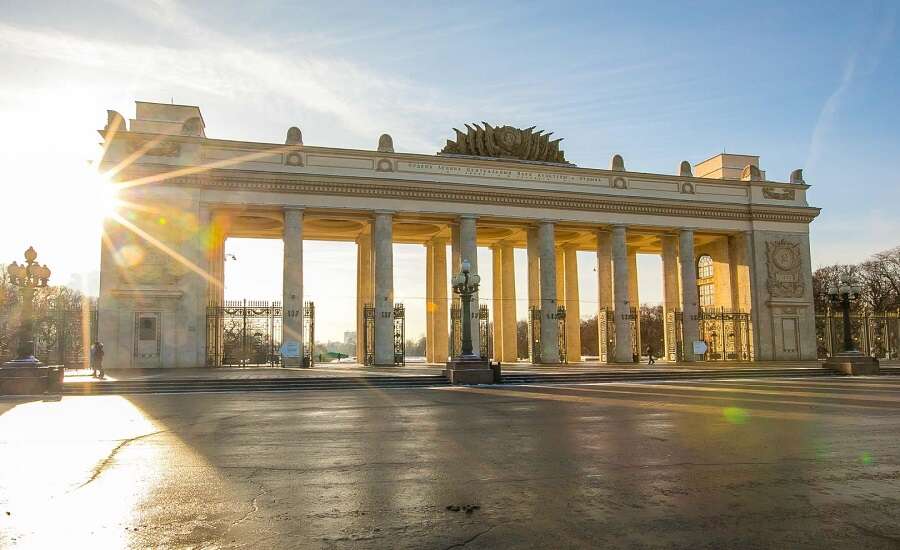
Photo from https://parkseason.ru/
Following the October Revolution, Vladimir Lenin travelled around Moscow to find a suitable site for the first All-Russian Agricultural and Artisan Industrial Exhibition, which would reveal opportunities for socialist development of agriculture and industry. Lenin decided on the wasteland alongside the Moskva River, which was cleared with a programme of community work. In 1923, the exhibition began. It encompassed 250 pavilions dedicated to different themes of agriculture and industry, and was divided into thematic zones, such as villages, livestock, crops, engineering, railways, republics of the USSR, and foreign countries. The organisation of the exhibition demarcated the future layout and size of Gorky Park, and the paths, ‘zones’, and main square of the exhibition have been preserved until the present day.
In March 1928, Moscow City Council decided to establish a park of culture and recreation on the site of the former exhibition, which would also encompass the Neskuchny Garden. Moscow’s residents were instrumental in the construction of the park – they voiced their desires for events spaces, physical education and leisure facilities, and gave up their weekends to build the park. The park’s main architect was Konstantin Melnikov.
Did you know? Konstantin Melnikov also helped to construct Lenin’s Mausoleum and the Rusakov Worker’s Club, one of Moscow’s Constructivist masterpieces.
Over 100,000 Muscovites flocked to the opening of the park on 12th August 1928. The brand-new park was equipped with two theatres, a cinema, nursery, reading room, restaurant and café, music stages, sports arenas, rowing boats, and even a giant helter-skelter slide. Unfortunately, because of the vast size of the crowd and the general excitement, the park was damaged and closed until September.
Did you know? The park was not named after Maxim Gorky, writer and founder of Socialist Realism, until 1933.
In 1929, Betty Glan – at the mere age of 26 – became director of the park. She decided to reconceptualise it, uniting leisure, design, and ideology with the help of Moscow’s most eminent architects, designers and artists. Over the next decade, more cultural venues were established in the park, the Pushkinskaya Embankment along the Moskva River was developed, and the landscaping of the park was carefully cultivated. Architect Alexander Vlasov was particularly influential, and won the Grand Prix at the 1937 World Exhibition in Paris for his design of Gorky Park. This period under Glan’s directorship until 1937 was known as the ‘golden age’ of Gorky Park, which became not just a place for recreation, but a public space where Soviet culture and everyday life could be proudly displayed.
Did you know? During the Second World War topical events were held in Gorky Park, such as the championship in bayonet combat, grenade-throwing competitions, and air defence training. What’s more, an exhibition of captured enemy weapons – tanks, artillery, aeroplanes, and more – was organised in Gorky Park and continually updated throughout the war.
In the post-war decades new attractions were continually added to Gorky Park. These included the majestic 24-metre triumphal arch at the entrance to the park, an astronomical observatory (which remains open today), the famous Ferris wheel (unfortunately dismantled in 2008), and a fountain with lights and music.
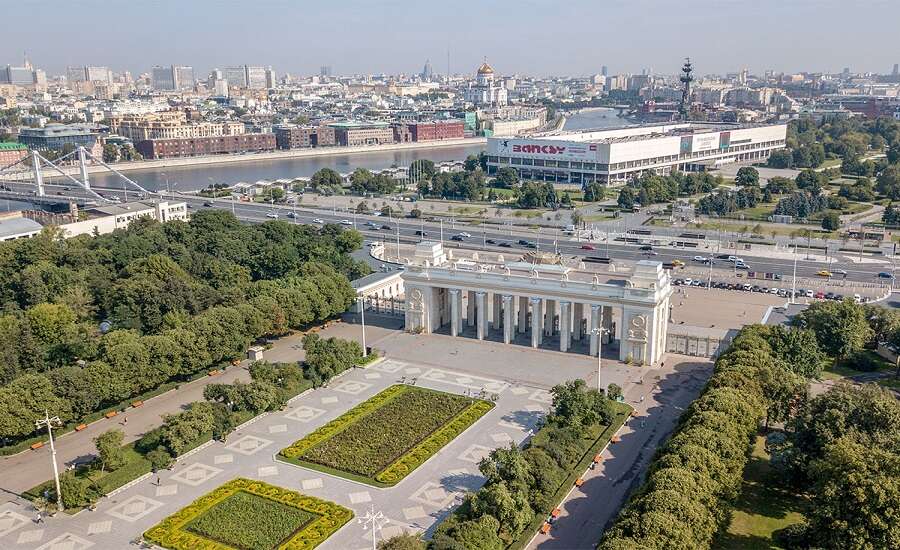
Photo from https://countryscanner.ru/
The Gorky Park ensemble continued to flourish as a centre of culture and recreation in post-Soviet Russia. The adjoining Muzeon Park of Arts was founded in 1992, and Garage Museum of Contemporary Art was established in Gorky Park in 2008. The ensemble underwent serious reconstruction in 2011. Many new sports facilities were added, including centres for beach sports and extreme sports, bicycle paths and sports equipment rental hubs, and much effort was devoted to reviving original buildings, sculptures, and landscape compositions. Two years later, the embankment of the Moskva River from the southern tip of Zamoskvorechye Island all the way to Sparrow Hills was redeveloped and pedestrianised, making it possible to peacefully walk or cycle along the Moskva for many kilometres.
While exploring the treelined paths of Gorky Park, you’ll come across a number of attractions. To the west of the main entrance, near the river, is a beautiful geometric bandstand used for music and literary evenings in the Soviet period. As you head down the central alley of Gorky Park from the main entrance, you’ll see a statue of Maxim Gorky on your right, and discover the light and music fountain with its dancing jets of water – find the schedule of its performances here.
Did you know? Don’t be afraid to feed the red squirrels and birds you encounter on your walk around Gorky Park – there are even vending machines which sell special food for the animals!
The southern section of Gorky Park is occupied by the Golitsynsky Garden. In 1802, the Golitsyn Hospital was founded here as a hospital for the poor; it still adjoins Gorky Park today. Gardens were created as a relaxation place for patients, extending from the hospital building to the riverbank, and included landscaped gardens, a Chinese Bridge, and two ponds. On the riverbank is the Rotunda of the Golitsyn Hospital, which has been preserved since the 19th century. There is also a rose garden and fountain by the Bolshoi Golitsynsky Pond.
Did you know? In the Golitsynsky Garden is also located an unusual architectural monument – a public toilet designed by Alexander Vlasov in the 1930s, which is recognised as an ‘object of cultural heritage’!
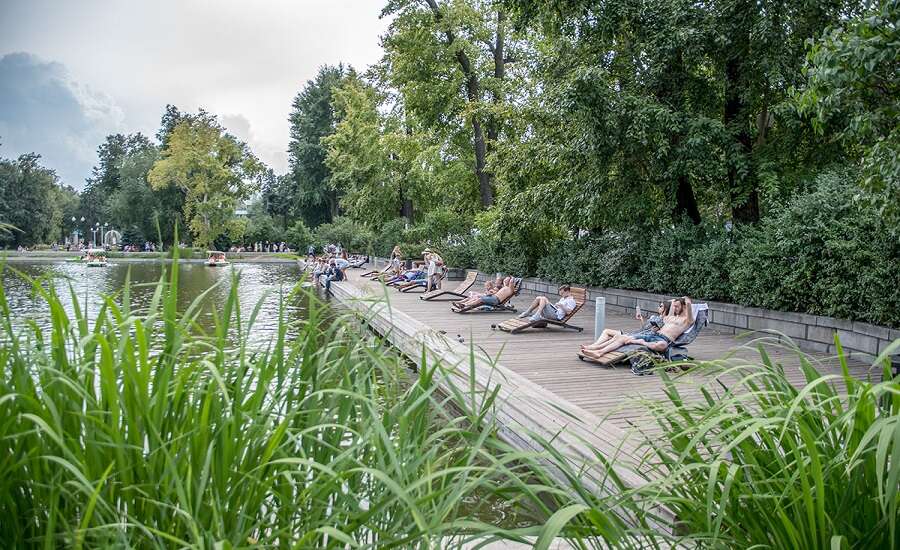
Photo from https://countryscanner.ru/
Gorky Park’s extensive and varied grounds aren’t only good for walks! You can relax on the water by renting boats to sail on the Pionersky and Bolshoi Golitsynsky Ponds, or visiting the Olivkovy Beach on the Pushkinskaya Embankment to sunbathe. As well as this, you can hire bicycles, electric scooters, longboards or even roller skates to explore the park and embankments, play table tennis, visit the sports complex to play football, basketball, handball, badminton or volleyball, or visit the Vans skatepark or Nike sports centre for workouts and classes such as rooftop yoga.
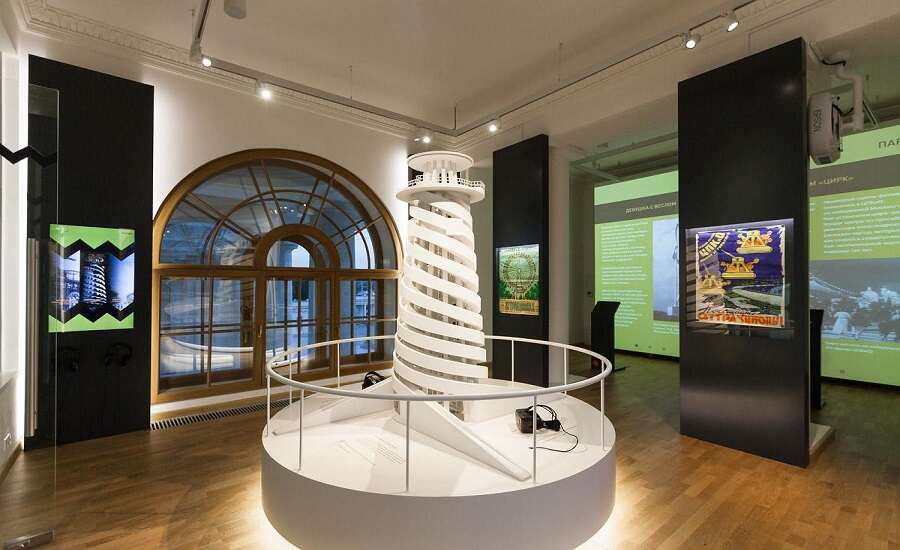
Photo from http://themedium.ru/
Visit the Gorky Park Museum, located in the left pier of the entrance arch. The current exhibition is dedicated to Gorky Park in the ‘golden age’ of the 1930s, and shows the development of Moscow’s central park through the eyes of Betty Glan. There is an observation deck on top of the arch, which offers a lovely view over the park and Moscow’s skyline.
Did you know? In the entrance arch there is also a gift shop where you can purchase balls, frisbees, blankets, and other items to enjoy your visit to Gorky Park.
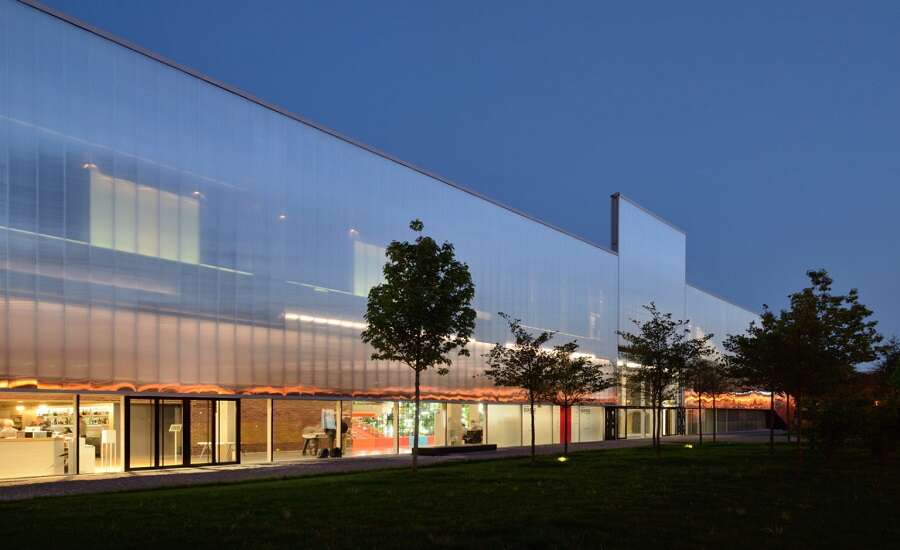
Photo from https://muzeolog.com/
In Gorky Park you will find Garage Museum, Russia’s first philanthropic institution dedicated to contemporary art, founded in 2008 by Roman Abramovich and Dasha Zhukova. 10 major exhibitions are hosted each year to showcase the work of established and up-and-coming artists. Also organised are a rich programme of events including curator-led excursions, workshops, masterclasses, lectures, concerts, performances, festivals, and film screenings at Garage’s outdoor cinema. Read our article about Garage Museum of Contemporary Art to learn more.
There are plenty of excellent cafes and restaurants dotted around Gorky Park, where you can stop for a quick coffee or enjoy a long meal with a view. They include the stylish lakeside café Ostrovok (Little Island) and upmarket restaurant Vremena Goda (Seasons) which serve European and Russian food, colourful lakeside Thai restaurant Lebedinoe Ozero (Swan Lake), trattoria Merkato with its huge summer terrace, restaurant Syrovarnya (Cheese Factory) with a menu focused on its homemade cheese, food-truck court Restoparking which is stylised as a drive-in café, and ice-cream and tea shop Chaynaya Vysota.
Gorky Park is bordered by Muzeon Park of Arts, Neskuchny Garden, and Sparrow Hills Nature Reserve. This huge ensemble curves for eight kilometres along the bank of the Moskva River, providing a beautiful oasis of green in Europe’s biggest city.
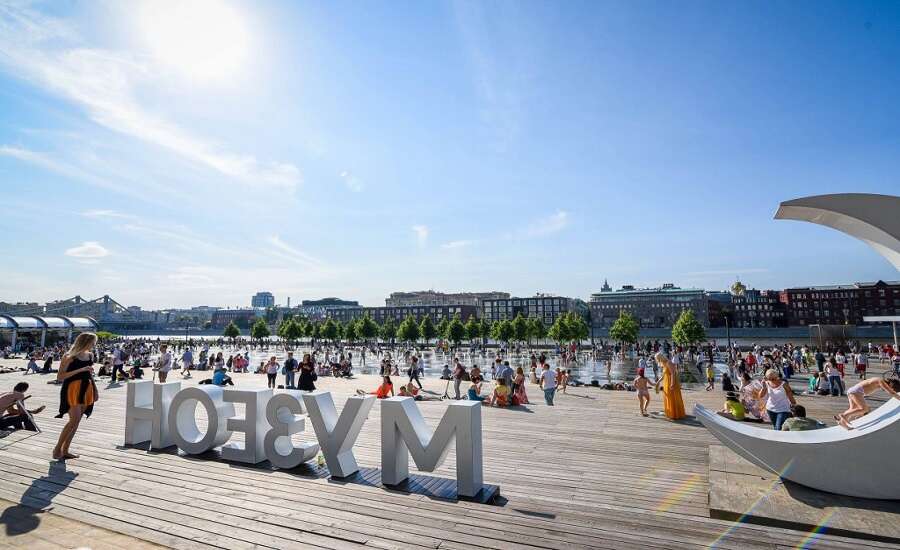
Photo from https://new-magazine.ru/
Muzeon Park of Arts is the largest open-air sculpture museum in Russia, home to 1,000 sculptures by Soviet and Russian sculptors, including those by famous artists. A large part of Muzeon is occupied by the New Tretyakov Gallery, which houses Russia’s most complete exhibition of national art from the 20th century to the present day. The pedestrianised Krymskaya Embankment which extends alongside Muzeon has recently undergone redevelopment, and is one of Moscow’s most popular spots to relax.
Neskuchny Garden is the oldest park in Moscow, founded in 1728 by Prince Nikita Trubetskoy, who threw fantastic festivities in his manor house and gardens – neskuchny means ‘merry’ in Russian. Many other noble families also built their country estates in this area, which became a public park and garden after being acquired by the royal family. Today, the Neskuchny Garden is home to historical buildings, fountains, and gardens from the 18th and 19th centuries, sports facilities, an open-air theatre, and a huge greenhouse which supplies flowers to Gorky Park.
Sparrow Hills Nature Reserve is a huge forest park lining the steep bank of the Moskva River and the only specially protected nature area near the city centre. It is home to ecological trails, ponds, natural springs, rare species of plants and animals, many spots for picnicking, cafes, and a mini zoo. At the bottom of the park lie the Vorobyovskaya and Andreevskaya Embankments, with promenades along the Moskva River, a beach, and piers offering boat trips.
As with Gorky Park, Sparrow Hills is hugely popular for sports and outdoor activities in all seasons. A new winter sports complex with snowboarding, ice skating, and ski tracks and jumps is currently under construction. When the weather is pleasant, you can rent a bicycle to ride the 8 kilometres along the river from Muzeon to Sparrow Hills.
Essential information for visitors
Address and contact details
Gorky Park, Krymsky Val, 9, Moscow, 119049
Website: https://park-gorkogo.com/
Email: official@park-gorkogo.com
Telephone: +7 (495) 995-00-20
Nearest metro: Oktyabrskaya (570m), Park Kultury (860m)
Opening hours and tickets
Join us on Facebook
We invite you to become a fan of our company on Facebook and read Russian news and travel stories. To become a fan, click here.
Join our own Russian Travel, Culture and Literature Club on Facebook. The club was created to be a place for everyone with an interest in Russia to get to know each other and share experiences, stories, pictures and advice. To join our club, please follow this link.